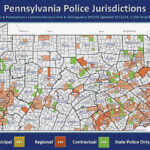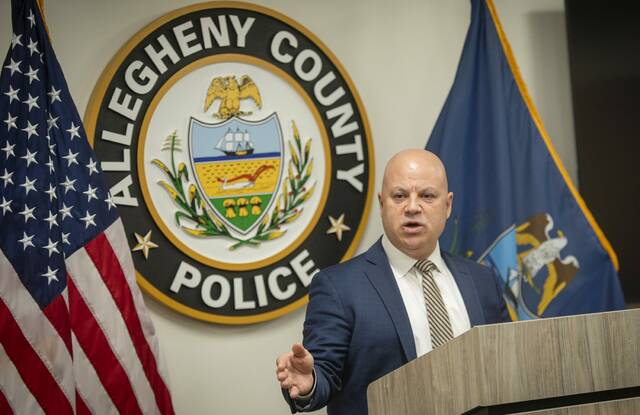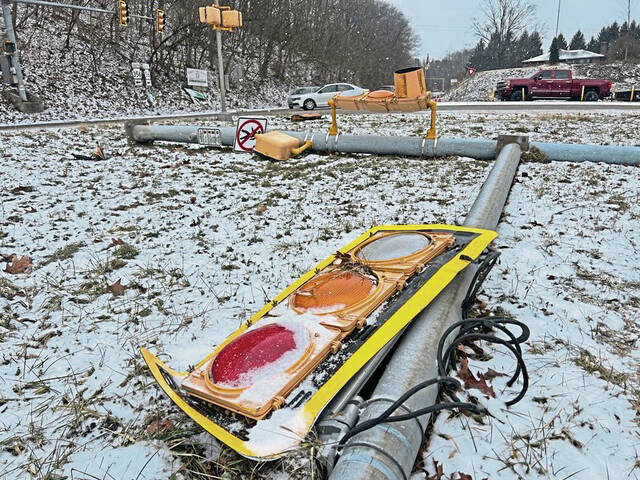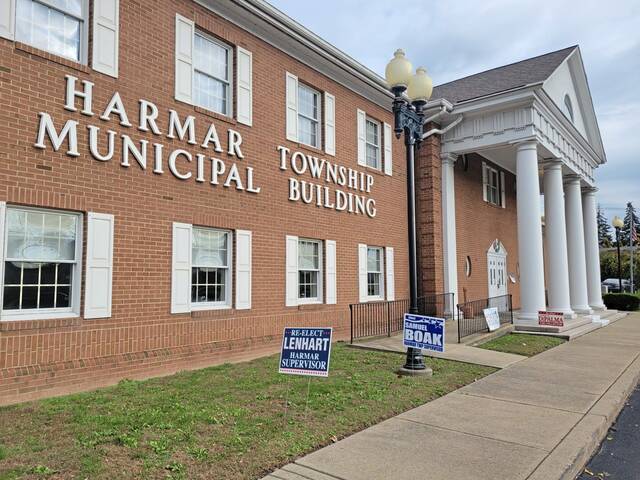The Allegheny Valley Regional Police Department’s budget increased by 5% this year — but it still costs its member communities less than what they were paying for their individual departments years ago.
Cheswick, East Deer and Springdale Township each will pay about $272,000 toward the regional police force this year.
In 2017, Springdale Township was paying about $373,000 for its own department and Cheswick was paying $324,000, said Pam Manning, secretary for the regional department. While the towns had differing numbers of police officers when they operated independently, both have more officers available under a combined force.
“Seven budgets later, it’s still not what they were paying,” she said.
Discussions about police regionalization have gone on in Pennsylvania communities for years.
Recently, Leechburg cut off discussions with Parks Township for a regionalized police force, saying it isn’t a good fit for borough residents at this time. In August, officials from Apollo, North Apollo and Kiski Township signed letters of intent to explore merging police coverage but have since left discussions. Even as far back as 15 years ago, an attempt to combine East Deer and Frazer with Tarentum for police services fell flat.
But when regionalization or merged forces work, communities realize many benefits, officials say.
Cost savings is one of the biggest. Cheswick and Springdale Township are saving 12% and 14%, respectively, over what they were paying before the regional department was created in 2019.
“It’s, ‘Can you provide a service with the amount of money provided to you?’ ” Chief Michael Naviglia said. “We’ve proven we can.”
When looked at in terms of how much police services cost per person annually in each municipality, it’s $165 in Cheswick, $182 in Springdale Township and $191 in East Deer, Manning said.
The department has 12 officers, seven of whom are full time.
Serving three communities does not alter response times, Naviglia said, as officers are always in one of two zones — one on the Cheswick side, and the other on the East Deer side.
“There’s no increase to response times,” he said. “We haven’t seen any of it.”
Joint forces ensure safety while being fiscal
The Ligonier Valley Police Department is the only regionalized force in Westmoreland County. There, too, officials say the move saved money.
Ligonier Township pays about 71% of the department’s budget this year and Ligonier Borough’s share is about 29%, according to Michael Strelic, township manager.
The municipalities merged forces in 2019. The cost shares were determined by the cost of the independent forces before the merger and have been adjusted recently because of the municipalities’ populations, Strelic said.
Having a merged force is more cost-effective compared to when the township had its own department, Strelic said. It also allows two officers out at all times instead of just one when the township was on its own.
“Certainly, getting the borough to pitch in 29% is cheaper than 100%,” Strelic said.
Ligonier Township pays $715,734 for the police department this year, which equates to about $120 per resident per year, Strelic said.
Strelic said he has not heard complaints about response times.
“I’ve heard a lot of praise for response times,” Strelic said. “They try to get out and be seen.”
He said surrounding communities rely on state police coverage, which can have longer response times.
Having the joint force also allows officials to retain officers. When the township had its own force, it relied on part-time officers, who were hard to retain. Although costs increase when full-time officers are hired, it provides better retention, Strelic said.
But regionalization isn’t the only way for communities to provide joint police protection.
Tarentum and Brackenridge merged forces in August 2023, with Tarentum absorbing Brackenridge’s personnel and equipment. Since then, operations have been smooth, said Tarentum Borough Manager Dwight Boddorf.
This year, Brackenridge will pay Tarentum roughly $470,000 for police coverage, which accounts for about 27% of Brackenridge’s total budget, Boddorf said. The cost per officer is about $146,300, including salary, benefits, equipment, insurance and other necessary expenses.
The department rosters 13 officers: one chief, one lieutenant, four sergeants and seven patrol officers.
“The collaboration has fostered efficiency, shared resources and improved public safety for both communities,” Boddorf said.
In 2024, the department handled about 3,347 calls in Tarentum, 1,570 calls in Brackenridge and 208 calls in other jurisdictions, Boddorf said.
“There have been no significant issues with response times to Brackenridge, as patrol zones are designed to ensure coverage across both boroughs,” Boddorf said.
The joint force has reduced overhead costs, Boddorf said. He said other benefits include an improved officer presence with a more significant combined force; streamlined operations including training, equipment and administrative tasks; and strengthened community relationships.
“Additionally, we have unexpectedly fostered a stronger government-to-government relationship between Tarentum and Brackenridge, which has helped align some local ordinances across municipal boundaries,” Boddorf said. “This has improved consistency and service delivery.”
A statewide look
Regionalization is nothing new for communities in northwestern Allegheny County.
For decades, the Northern Regional Police Department has served Pine, Marshall and Bradford Woods. It added Richland in 2006.
“That’s been so far, so good,” Chief Bryan DeWick said of the four-year contract with Seven Fields. “It hasn’t been a huge burden on us. We’ve got a lot of positive feedback from residents.”
Because Bradford Woods has a smaller population than the other three townships, it pays a flat 4% of the department’s budget each year, DeWick said. Rates for the other three townships are based on the percentage of calls generated by each town.
The total police budget this year is just under $ 8 million, DeWick said. He said participating municipalities realize cost savings over having their own departments. The regional force provides better service than if each municipality operated its own, he said. Northern Regional does its own investigations.
“We do everything in-house,” he said.
With covering more than 50 square miles, DeWick says the department’s emphasis on community policing provides a feeling of a hometown police force.
“We maintain community relations,” he said. “It comes down to the culture we’ve instilled in our officers. We emphasize community policing.”
DeWick said there are no issues with response times to municipalities. In December, the department had 786 calls for service. At full staff, there are about seven to nine officers available at any time.
“Regionalization is a great thing,” DeWick said. “It obviously saves money and allows a more professional and better-trained police department.”
Currently, there are 41 regional police departments in 28 counties statewide, covering a combined population of about 725,000, said Justin Backover, state Department of Community and Economic Development spokesman. Twelve of the regional departments formed in the past five years, he said.
There are 2,560 municipalities in Pennsylvania; 1,304 of them have state police coverage only, Backover said. Another 887 municipalities have their own departments.
Of the remaining municipalities, 143 comprise the 41 regional police departments, and 226 municipalities contract services from a municipal or regional police department for their police coverage.
Municipalities commonly save money when they regionalize or absorb, Backover said. He said the average per capita cost for a municipal police department in 2023 was $290; that cost for a regional police department was $204 — an almost 30% savings per capita.
Backover said most municipalities that regionalize report lower costs, more combined officers, higher salaries, better officer retention rates, increased morale, more patrol coverage, faster response times, fewer part-time officers, less overtime, improved administration, more patrol supervision and training, less duplication of services in a region and potential regional police grants.
Some “minor” disadvantages to regionalization that DCED has heard, Backover said, are municipalities reporting less direct municipal control and less availability for officers to conduct minor municipal tasks or services, such as parking meter maintenance or issuing permits.
They also report a perceived loss of direct citizen contact and loss of current ranks or assignments of officers, though none of the regional departments locally report that problem.
Mike Vogel, chief of the Allegheny County Housing Authority police and president of the Pennsylvania Chiefs of Police Association, could not be reached for comment for this story but said in an August interview that he is a “big proponent” of regionalization.
Officials from the Fraternal Order of Police, a union representing a number of local police departments, did not respond to requests for comment.
Regionalization not always the answer, some officials say
Sometimes regionalization is not recommended. A proposed regional force involving Sharpsburg, Aspinwall, O’Hara and Blawnox was not recommended five years ago because it would have meant higher costs for those municipalities.
But that didn’t stop O’Hara and Blawnox from merging their forces this year much the same way Tarentum and Brackenridge did.
O’Hara absorbing Blawnox’s police force seemed to make the most sense for both municipalities, said O’Hara Manager Julie Jakubec.
“The township and Blawnox realized that there was a ‘people power’ issue,” Jakubec said. “Blawnox was having trouble hiring additional officers like many communities are, as there is a police officer shortage.
“Through mutual aid, we have always responded in Blawnox when needed. It was felt that we should address possible staffing issues in Blawnox and mutual aid before things would hit critical mass.”
The absorbed force went into effect Jan. 1.
Blawnox will pay O’Hara $463,300 this year for police service, which is about $2,000 less than what the borough allocated last year operating its own force.
O’Hara absorbed three of Blawnox’s employees — two patrol officers, and their chief, Patrick Goodman. Goodman is now O’Hara’s deputy superintendent of police.
Blawnox pays for the salary, social security and medicare taxes, and benefits for Goodman and the two patrol officers. O’Hara pays those costs for the existing 15 officers, including Superintendent Jay Davis.
“This is designed so that each community pays their fair share of the police budget including capital purchases, such as police vehicles,” Jakubec said. “This is relatively cost-neutral for township residents as we are paying for what was existing, and Blawnox is paying for their officers and their costs.”
Status quo works for others
Springdale Borough participated in a study years ago, said Councilman Dan Copeland, but a regionalized force was not feasible because of pension obligations.
“(Our) pension fund would be way out of line with whatever other departments we would be looking at,” Copeland said.
At full complement, the borough has nine officers: one chief, two sergeants and six patrol officers. It budgets costs at around $1 million, Copeland said. The force gets around 150 to 200 calls a month, he said.
Copeland said the borough has a 24/7 force and always has two cars on duty.
“We want to keep our department the way it is,” he said. “There’s always cars riding through Springdale. Our residents say they see police cars out all the time.”
He said regionalization is not something Springdale Borough would consider.
“We like having our own police,” Copeland said. “We have our own fire department, we have our own police department. We’re a self-sufficient borough.”
Frazer and the Allegheny Valley Regional Police Commission had discussed a possible merger last year; but after crunching their numbers, Frazer officials chose not to go with the regional force, said Secretary/Treasurer Lori Ziencik.
“We have potential land development occurring,” Ziencik said. “It just wasn’t time to make that move. We may need the department in the future with the growth we could potentially have.”
Frazer’s department has four full-time officers and one part-timer. The municipal budget for this year allocates $612,000 for township public safety. That number includes contributions to the township’s volunteer fire departments.
“It’s working beautifully,” Ziencik said.
Asked if the township would ever consider a regional force, Ziencik said: “We’ll have to cross that bridge when we get to it.
“For now, we have a stable department.”
Fawn Secretary/Treasurer Pam Ponsart said regionalizing or absorbing is not something the township is considering. Fawn has two full-time officers — a chief and a sergeant.
“We’re fine the way we are,” she said.
Ponsart did not have an average number of calls the department received. She said that mutual aid, like services from Tarentum, assist when needed; just as Fawn would do in neighboring jurisdictions.
“All these towns cover one another,” she said.
Etna Council president David Becki said that currently, borough officials are satisfied with the borough’s police department and the coverage and services it provides.
“We are especially proud of their commitment to ‘community’ policing,” Becki said.
Etna Borough Manager Mary Ellen Ramage said the department had 3,488 calls last year. The total police budget this year is $933,093 which is just under 14% of the borough’s total budget.
“However, being realistic, and aware of the changes occurring in this area, we are always willing to consider other options, including regionalization,” Becki said. “But that is not something that is currently under consideration.”





















